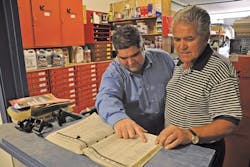Carl Garcia Jr. is an idea guy. Where others might see an empty lot, he pictures not just a bigger repair shop, but a training center. And why not a library? How about a satellite branch? “I love dealing with the new and unknown,” says Garcia, owner of Carl’s Collision Center in Fall River, Mass., a Mercedes Benz–certified shop just 50 miles outside of Boston with a specialty niche in repairing high-end vehicles.
Since 2005, Garcia’s business has grown from a 16-man, 6,000-square-foot shop with $2.5 million in revenue to a 33,000-square-foot repair and I-CAR training center with 60 employees and $8 million in revenue. Even in the tough economy, Carl’s Collision added employees last winter, and Garcia estimates that his business will grow about 11 percent this year. But his success wouldn’t have happened without the guidance of his banker and accountant, Garcia says, who have helped him finance new equipment and put processes in place to operate more efficiently. He counts those relationships as critical to sustaining future growth and profitability.
“It doesn’t matter if you have 60 guys or one employee—you need a relationship with an accountant to understand how to analyze your business,” Garcia says. “And a relationship with the bank supports your growth, whether you need a $10,000 loan to buy equipment for your first shop, or to buy a $1 million building.” Carl’s Collision Center’s growth is especially notable because of the lack of any direct-repair program (DRP) relationships. “Massachusetts doesn’t allow it,” Garcia says. He is one of two collision repair shop owners on the Massachusetts licensing board, which oversees and enforces the regulations.
Without any DRPs, Garcia says, he has had to build his business with an eye toward strategy, niche and building a reputable name. “It’s all about trying to get to know customers, finding good-size accounts, and pushing out 100-plus cars a week by meeting one person at a time.” He’s had some good luck, too. As Garcia was opening his new shop, a body shop working for the local Mercedes dealership closed, and Garcia hired many of its employees in order to gain that business, and pursued the certification necessary to service its cars. That has helped boost his business in hard times, he says. Because so many Mercedes are leased and need to be kept in mint condition, he sees a steady stream of customers.
Besides Mercedes and BMWs, Carl’s Collision services the cars for many fleet accounts, as well as Volkswagen, Audi, Subaru and Chrysler. “I could have a CEO of a major company and somebody making minimum wage in my shop at the same time,” he says. “The important thing is to treat everyone with the same dignity and respect, and it pays off.”
From Shop Floor to CEO
The son of Manuel (Carl) Garcia, Carl Jr. is a second-generation auto repairman who grew up helping out his father in his uncle’s shop. “I’d hang around the office looking through folders and find ways to make money for my father with my pen,” says Garcia, who, at his father’s insistence, earned degrees in accounting and criminal justice. By 1994, Garcia had started to bring in his own clients, and was itching to strike out on his own. So he and his father opened their own shop. “From the start I wanted to do everything modern,” Garcia says. “All urethane paint. High-volume, low-pressure paint guns.”
Garcia had bigger dreams too. He wanted to go after high-end clientele, and he knew he needed a bigger space and more money to buy the best training and equipment available. “I wanted a special niche and to go after the high-end cars like Mercedes and BMWs,” he says. “I wanted to emulate the kind of attention to detail that you would get at a high-end hotel like the Four Seasons in Boston, where everyone greets you by name. That’s how I wanted to treat my customers.”
A few years ago, Garcia started running into an old family friend, Joan Medeiros, who’d recently returned to Fall River from the Boston area as a commercial specialist for BankFive, a local bank. “I’d talk to her about my dreams, and she always had time to listen to me,” Garcia says. Driving home one night by a different route, Garcia spotted an empty building with a fenced-in lot—and suddenly, in his mind, his big dream had bricks and mortar.
But to buy that building, he needed to borrow $1 million. “I turned to the bank I was dealing with at the old shop, and they laughed at me,” he says, as did other bankers. “When I approached Joan, she said, ‘We’re going to get it done.’” Medeiros helped Garcia draft a business plan, which forced him to articulate the “what” and “how” that would drive his dream—vision statement, strengths, weaknesses and short- and long-term plans. “Before, like most small businesses, I didn’t have a clue,” he says.
With BankFive’s backing, Garcia was able to purchase a $200,000 Car Bench jig straightening machine—one of only seven in the country in 2007, on which Porsches, Ferraris and other luxury vehicles are built and repaired—as well as to open the in-house training center that offers I-CAR, Car Bench and other classes.
Driving Efficiency
If Garcia’s banker helps give form to his grand vision, his accountant is the foreman driving the day-to-day operations that, without vigilance, might otherwise derail that plan. Garcia turns to Helder Medeiros (no relation to Joan Medeiros), the son of one of Garcia’s employees, as his accountant and friend. “Working with someone who can analyze a body shop as a business has really helped me look at things differently,” Garcia says. For example, his accountant helped him incorporate his shop, and advises him on the latest tax credits and rules, including the proper way to handle leases and to write off equipment. Helder Medeiros helps Garcia keep an eye on the big-picture snapshots of a company’s financial health: profit and loss, net worth, cash flow.
Helder Medeiros also helps Garcia quantify his progress toward his short- and long-term business goals, such as boosting profitability each year, on a weekly basis. “We run reports that compare week to week, month to month and year to year,” Garcia says. “So we can see how much ‘re-do’ work we did, how much we did on warranty, how many cars we fixed, total sales we brought in and our total labor and parts costs.”
To improve what he calls his cost effectiveness, Garcia has spent much of his time in the new space standardizing his operating procedures for efficiency. For example, all incoming cars are X-rayed and sanded the same way. Carl’s Collision has also created a paint library. Every time technicians spray a car, they also spray a card that they can refer to again. “So if a certain blue 2007 Mercedes is coming in, we just lay that card on the car to see if it’s a good match,” he says. “We check the notes in the folder for what issues we had. That’s going to help us be much faster on future jobs.”
Helder Medeiros has also helped him see the value in quantifying how time and materials either added to or detracted from the value of a job. For example, Garcia says, spending two hours extra on 50 cars each week, out of about 120 cars total, might not seem like a big deal. But that’s 100 hours, and at $35 an hour in labor, $3,500 a week. In one year, those hours translate to $182,000. “Just because we raise the price doesn’t necessarily mean we’re making more money.” On the other hand, Garcia says, eliminating waste from parts and materials allows shops to make more money from their most profitable asset—labor. “You only make between 20 and 30 percent each on parts and materials, but at least 50 percent of your revenue from labor,” he says. “If you can boost the percentage of your income from labor to 53 percent, you’ll increase your gross profit by at least one percentage point,” he says. For a shop doing $3 million in sales, that’s $30,000.
Accordingly, to better track waste, Garcia has opened a parts division. “Say a guy needs a can of paint. He technically buys it from me, and now I can track how much material each guy uses.” Garcia’s shop now also budgets its spending on materials according to how much money it’s bringing in weekly—something the shop never used to do. Garcia forecasts how many cars he’s likely to work on each week. “We need to know if there’s any potential slowdown,” he says. Using a computer tracking program, he can tell where each car is in the shop and which workers need to float to different departments to help busier areas. Garcia estimates that about 35 people, plus about four part-time extras, work in the collision center’s seven departments: X-ray, body work, framework, mechanics, engine work, paint, assembly and recon (cleaning up and detailing).
If he can find the right people and locations, Garcia dreams of opening satellite locations to funnel more cars to Carl’s. He’d also like to develop a partnership with a major paint company, where his shop would act as sort of a live training center to “solve real problems in a real environment,” instead of the perfect conditions of a laboratory. “I’d like the vocational schools to be able to come down here and do hands-on training,” he says. “I’d really love to open myself up to the community.”




